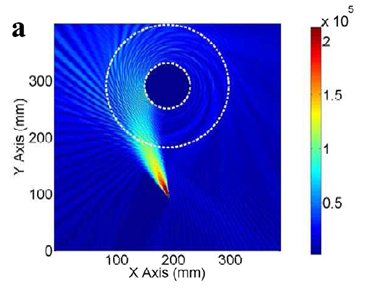 Cloaking technology used to create a region of space that allows microwaves in, but not out again.
Cloaking technology used to create a region of space that allows microwaves in, but not out again.If you have not heard of metamaterials and what they can do, where have you been? Most of the media coverage so far has focused on invisibility cloaks but that is just the start of the fun physicists can have with this stuff. Only a few weeks ago we were discussing how to recreate the big bang inside a metamaterial. And earlier this year, a group of physicists suggested that it ought to be possible to create a black hole using metamaterials. That is an interesting idea but a demonstration would be more exciting.
If you have not heard of metamaterials and what they can do, where have you been? Most of the media coverage so far has focused on invisibility cloaks but that is just the start of the fun physicists can have with this stuff. Only a few weeks ago we were discussing how to recreate the big bang inside a metamaterial. And earlier this year, a group of physicists suggested that it ought to be possible to create a black hole using metamaterials. That is an interesting idea but a demonstration would be more exciting.
Step forward Qiang Cheng and Tie Jun Cui at the State Key Laboratory of Millimeter Waves at Southeast University in Nanjing, China, who have used metamaterials to create the world' + char(39)+ N' s first artificial black hole in their lab. Yep, a real black hole.
That is not quite as scary as it sounds. A black hole is a region of space from which light cannot escape (that is why it is black). According to Einsteins' + char(39)+ N' theory relativity, black holes form when space becomes so distorted by a large mass that light cannot escape its gravitational field.
But gravity need not be involved. Metamaterials also distort space, as far as light is concerned anyway (in fact there is a formal mathematical analogy between these optical and gravitational distortions). Physicists have already exploited this distortion to steer light around an object within a metamaterial to create an invisibility cloak. If that is possible, then more exotic distortions ought to be possible too.
Now Qiang and Tie have created a metamaterial that distorts space so severely that light entering it (in this case microwaves) cannot escape.
Their black hole consists of 60 layers of printed circuit board arranged in concentric circles (see picture below). The printed circuit boards are coated in a thin layer of copper from which Qiang and Tie have etched two types of pattern that either resonate at microwave frequency or do not.

In their experiments, they have measured microwaves at 18 GHz going in and none coming out. And the circular symmetry of their metamaterial means that the microwaves are absorbed in all directions at once. What they have built is the world' + char(39)+ N' s first artificial black hole. (In case you are wondering, the energy absorbed by the black hole is emitted as heat.)
That is an exciting piece of physics and not just because it is a headline grabber. Artificial black holes could have important applications not least as light harvesters for photovoltaics. The prospect of a black hole in every household may not be as far-fetched as it sounds.

 Previous page
Previous page Back to top
Back to top







